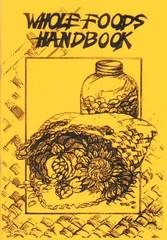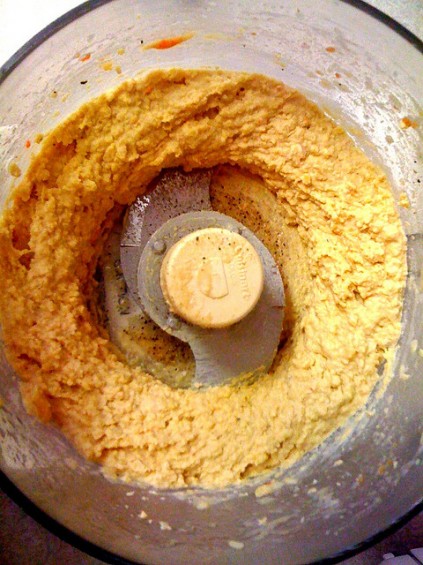An Excerpt from the Wholefoods Handbook – ‘Chickpeas’
 Chickpeas (Garbanzos)
Chickpeas (Garbanzos)
Chickpeas, native to Asia, are a key ingredient in Middle Eastern and Mediterranean cookery. They’re tan and shaped like a small hazelnut. Chickpeas contain more iron than other legumes and are a good source of unsaturated fats. Chickpeas have a nutty flavour and firm texture, retaining their shape well when cooked, making them ideal for salads. They can also form the basis for soups, stews, and casseroles, and be used in curries, pasta dishes and falafel. Mashed, they’re fine for spreads and dips, such as hummus.
To prepare: As for all legumes, presoaking promotes faster cooking, increases the availability of minerals, and improves digestibility. Soak 12 hours or overnight, using four cups water to one cup beans. Place drained beans in a pot with 3-4 cups water. Bring to a boil, reduce heat to low, cover and simmer about 4-5 hours, until soft. Or, pressure cook 2-3 hours.
Hummus: 2 cups cooked chickpeas; 1 or more cloves garlic, pressed or chopped; 4 tblsp tahini; 4 tblsp lemon juice;
1/4-1/2 cup water. Blend in blender or processor until absolutely smooth. Add just enough water for desired consistency. Any or all of these can be added: 1/4 c chopped onion, 1/4 c chopped parsley, 1/2 tsp dill, 1/4 tsp ground cumin, 1 tblsp tamari.
The Wholefoods Handbook – The Little Kitchen Book That Every Organic Cook Must Have (and can have for only NZ$5).
The incredibly affordable Whole Foods Handbook is a concise guide to 120 basic products commonly sold in organic shops. The Handbook provides background information on each food, a nutrition profile and preparation instructions, including some recipes. It’s designed to introduce customers to products they may be unfamiliar with or not know how to use — to boost individual health, organic shop sales and organics throughout New Zealand, helping achieve Organic New Zealand 2020. It’s 56 very full A5 pages, a thorough A-Z all about foods sold in organic shops.
Earthcare Education Aotearoa is a charitable trust specialising in environmental education, organic growing, permaculture and community development. The Whole Foods Handbook was written by a trustee of Earthcare Education Aotearoa to be sold in support of the Trust’s objectives. Proceeds support organic and environmental projects in Golden Bay.
Prices for the Whole Foods Handbook:
Single copy, $5. 2-16 copies, $4.70 each. 17-100 copies: $4.20 each
Postage is $1 for 1 copy, $1.50 for 2-4 copies, $3 for 5-17
copies, and $5 for 18+.
The Story Behind the Wholefoods Handbook – by the author – Joanna Piekarski
When Ro and I put down roots in Golden Bay eleven years ago, GB Organics was a not-for-profit shop run by volunteers, and we took a weekly shift. Arawa wheat? Corrail lentils? We thought: ‘Let’s increase sales by letting shoppers know what all these unfamiliar foods are and how to use them!’ Info cards soon appeared on the bulk bins. Eventually the cards were expanded and compiled into a handy book. GB Organics Whole Foods in a Nutshell was soon selling well. Another idea we had was ‘Other organic shops can sell these books and the profits can be put to good use for our community and environment!’ With a new cover design, the Wholefoods Handbook was soon published by the charitable trust Earthcare Education Aotearoa. The price is kept low (Green$ also welcome) and to date more than 6000 copies have been sold to individuals and in organic shops and Bin Inns all over NZ.
To buy your copy today, email: [email protected]
loading...
loading...
Tags: Food



Hi Surely you do not cook chickpeas for 4-5 hours??? ..usually the time is about 45 minutes BUT with my Heylo Bags I reduce the cooking time to just 5- 8 minutes… you can read about my bags here in the happyzine mag ,,article called “its in the bag” Buy direct from me at [email protected] ..I look forward to your comment.Tish
loading...
loading...
My source for those instructions is Paul Pitchford’s “Healing with Whole Foods: Oriental Traditions and Modern Nutrition.” This is very slow, low-heat cooking. A shorter cooking time is possible, perhaps 2-3 hours, but I think 45 minutes for chickpeas is a bit optimistic. “Until soft” (can be mashed with a fork) is what’s important. Long, slow cooking is also better for digestibility.
loading...
loading...
I use chickpeas almost daily…I soak overnight and cook at a simmer for at least a half hour..by then they are soft and mushy..
I cook less for a nutty crunchy texture and more for making humus etc..but no more or less then 10 mins either side of 30mins.
loading...
loading...